AR Spectator Features: Enhancing Live Events with Augmented Reality
Updated On: November 13, 2025 by Aaron Connolly
What Are AR Spectator Features?
AR spectator features are digital tools that put real-time info, stats, and interactive layers right on top of live sports events using your phone or AR glasses. With these tools, fans get a more personal experience, which makes following the game feel a lot more engaging.
Definition and Core Benefits
AR spectator features mix augmented reality tech with live sports. They use cameras and sensors to read the environment, then drop digital content right where you’re looking.
One big perk is seeing real-time stats right on the field or court. Fans catch player speed, heart rates, and tactical layouts without glancing away. No more juggling between your phone and the scoreboard.
Personalised content delivery means you get to pick the info you care about. Maybe you love deep analytics, or maybe you just want the score. AR apps let you decide.
Improved game understanding is a lifesaver for newcomers. AR can spotlight key players, break down rules as things happen, and even replay moments from several angles. Sports suddenly become way more approachable.
Fans can vote on plays, unlock behind-the-scenes stuff, and sometimes even influence game features. Instead of just watching, you actually get to participate a little.
How AR Transforms the Spectator Experience
Traditional viewing keeps fans stuck with whatever they can see or hear in the stadium. AR spectator apps flip that by layering extra info right on top, without blocking the real action.
Watching a live event gets more immersive. Fans can spot “hot zones” where the action heats up, follow player movements, watch instant replays from their own seats, and even get commentary that matches their knowledge level.
AR tackles those annoying moments—like missing a key play or not getting why the ref made a call. It can highlight fouls, show slow-mo replays, and explain rules on the fly.
Remote viewers don’t miss out either. People at home can pump up the atmosphere with virtual crowd noise, switch camera angles, and connect with other fans through social features.
AR opens up new ways to make money, too. Sponsors can slip their branding into AR overlays, and fans might pay for premium content without the ads getting in the way.
Real-World Examples of AR Spectator Apps
A bunch of sports organisations have already rolled out augmented reality spectator features. Some football clubs use AR apps that show player stats when you point your phone at them during a match.
Basketball arenas have AR overlays for shot probabilities, player fatigue, and tactical setups. You’ll find historical comparisons and even predictions for upcoming plays.
Tennis tournaments have AR that tracks ball speed, shows where players stand on the court, and offers instant replays from different angles. The same app can give you interviews and backstage content.
Motor racing uses AR to show car telemetry, real-time positions, and safety updates. You can pick your favourite driver and see stats tailored just for them.
Cricket fans get AR apps with ball trajectory, batting averages, and bowling breakdowns. This really helps international viewers make sense of complicated plays and strategies.
Some venues even have AR navigation to help fans find their seats, food, and bathrooms. These apps sometimes show wait times for concessions or restrooms, which honestly, is pretty handy.
Essential Technologies Behind AR Spectator Features
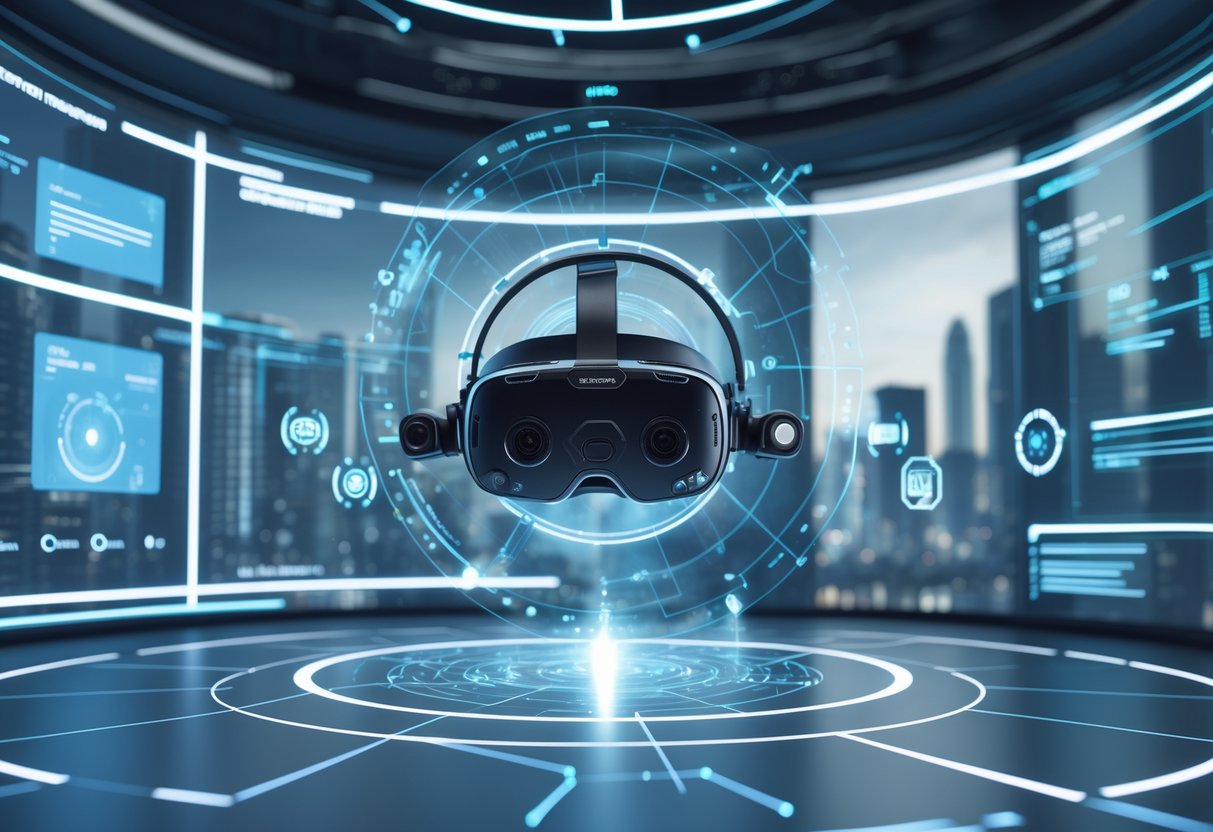
AR spectator experiences lean on advanced camera systems that process the real world in real-time. Sensors track movement and spatial details so digital content lines up perfectly with live action.
Components of an AR Camera Rig
The AR camera sits at the heart of any spectator AR system. Modern rigs combine several lenses and sensors that work together.
Primary Components:
- RGB camera for basic video footage
- Depth sensors to measure distances
- Wide-angle lenses for those huge stadium environments
- Stabilisation systems to keep things steady during live broadcasts
Most pro setups use stereo camera pairs that create depth maps by comparing two slightly offset views.
The AR Foundation camera rig is a go-to for mobile apps. It plugs right into smartphones and tablets—no extra hardware needed.
Processing Requirements:
- Real-time video encoding
- Low-latency data transfer
- High frame rates (60fps is basically the minimum)
- 4K resolution support
Stadium cameras need to handle the weather. Mobile AR cameras should be light enough for fans to carry around.
Sensors and Input Devices Used
AR spectator systems rely on more than just cameras. Extra sensors track where the viewer is and what’s around them.
Motion Sensors:
- Accelerometers for movement
- Gyroscopes to measure rotation
- Magnetometers for compass direction
Environmental Sensors:
- LiDAR for detailed 3D stadium maps
- Infrared sensors to work in low light
- GPS modules for finding your spot in big venues
Fans interact with AR overlays using touchscreens and gestures. Voice commands are catching on, especially in noisy stadiums.
Input Processing:
- Sensor fusion algorithms blend data from different sources
- Machine learning helps filter out noise and mistakes
- Real-time calibration keeps up with changing conditions
Pro setups use dedicated processors. Regular folks just use their phone’s built-in AR chips.
Spatial Mapping and Detected Planes
Spatial mapping lets AR systems understand real-world spaces in 3D. That’s how digital content stays anchored to surfaces and objects.
Detected Planes Technology: AR finds flat surfaces—fields, seats, scoreboards—and uses them as anchors for digital overlays.
The system keeps scanning for:
- Horizontal planes (like the playing field)
- Vertical planes (walls, goal posts)
- Angled surfaces (stadium roofs, ramps)
Mapping Process:
- Cameras grab the scene from several angles
- Computer vision picks out surface edges
- The system generates a 3D mesh model, right then and there
- Digital stuff gets placed relative to those planes
Challenges in Stadiums:
- Huge open areas with not many reference points
- Lighting changes from day to night
- Moving players and balls can mess with tracking
- The crowd itself shakes things up
Modern AR uses persistent anchors to remember plane locations. Digital overlays snap right back into place, even if you walk away and return.
If the spatial mapping isn’t accurate, the AR overlays just don’t look right.
Developing AR Spectator Apps in Unity
Unity is probably the most practical tool for building cross-platform AR spectator apps. You’ll need AR Foundation for device support, plus plugins for iOS and Android.
Unity Project Setup and Requirements
Start a new Unity project or tweak your old VR project. Make sure your Unity version supports AR Foundation 4.0 or higher.
Head to Edit > Project Settings > Player and set things up:
- Minimum iOS version: 11.0 for ARKit
- Minimum Android API: 24 for ARCore
- Turn on Auto Graphics API for smoother rendering
For iOS, add camera and mic usage descriptions. In iOS Player Settings, fill out Camera Usage Description with something like “This app uses the camera for AR features.”
You’ll need networking too. Bring in Normcore or another multiplayer tool before adding AR components. That way, VR users and AR spectators stay in sync.
Importing AR Foundation with Package Manager
Open Window > Package Manager in Unity. Change the dropdown to “Unity Registry” to see all packages.
Search for “AR Foundation” and hit Install. This package handles all the core AR stuff across both iOS and Android.
AR Foundation is a high-level framework. It manages camera feeds, plane detection, and tracking, so you don’t have to write separate code for each platform.
You get a few key components:
- AR Session to run the AR system
- AR Session Origin for placing virtual stuff in real space
- AR Camera (replaces Unity’s default camera)
- AR Plane Manager for finding flat surfaces
After installing, check out the AR Foundation samples for example scenes and prefabs. They’re a good starting point.
Using ARKit and ARCore XR Plugins
Grab the platform-specific plugins next. Install ARKit XR Plugin for iOS and ARCore XR Plugin for Android.
These plugins talk directly to Apple’s or Google’s AR systems. ARKit handles Apple devices, ARCore does Android.
Go back to Package Manager, search for each plugin, and install them. If you’re building for both platforms, get both.
Configure them in Edit > Project Settings > XR Plug-in Management. Tick the boxes for your platforms under both desktop and mobile.
Drag the AR Foundation Camera Rig prefab into your scene and get rid of the main camera. Connect the AR camera to your avatar manager’s head slot for correct placement.
Before building, switch to your mobile platform and make sure AR support is turned on in player settings.
Cross-Platform Support for AR Spectators
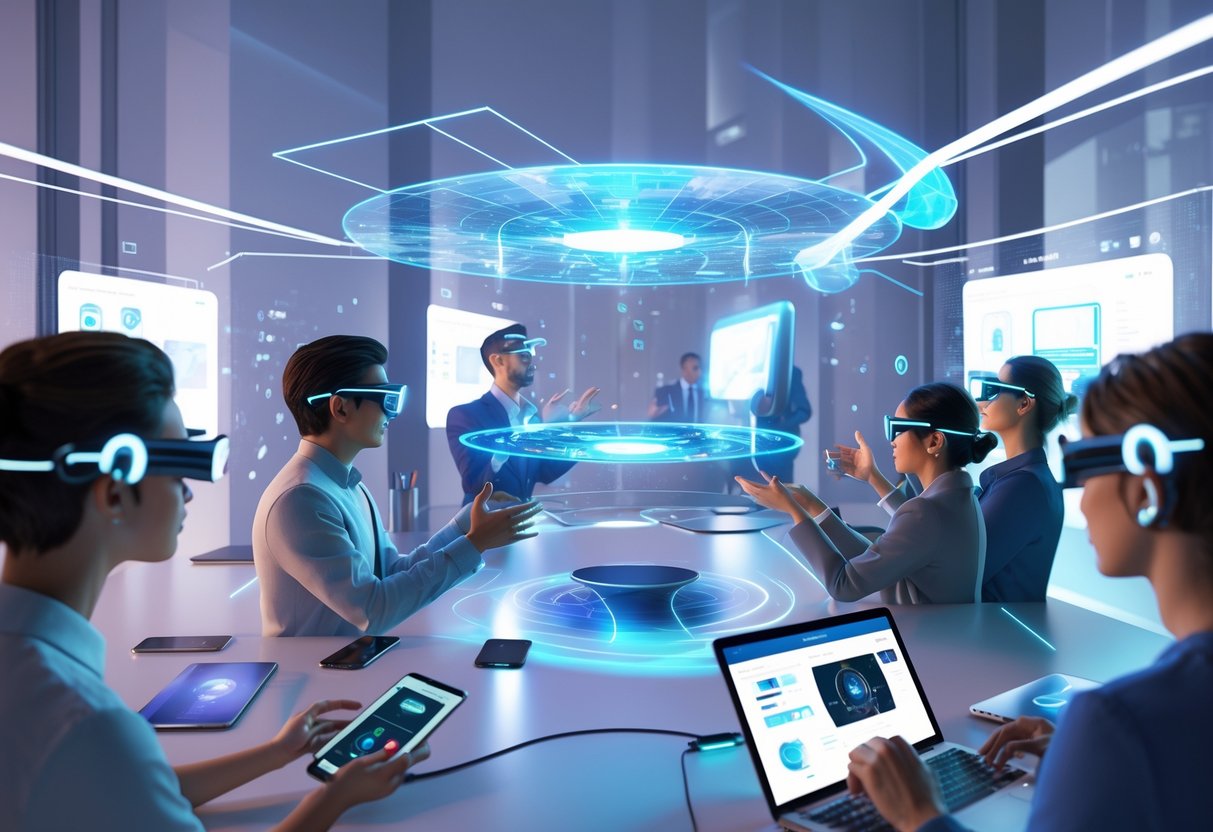
Building AR spectator experiences means paying close attention to iOS and Android differences. Each platform brings its own quirks and hardware strengths that shape how fans watch live esports.
Developing for iOS Devices
iOS AR development revolves around ARKit, Apple’s own AR framework. ARKit does a solid job with plane detection and world tracking, so you can drop virtual displays right into real-world spaces.
Key iOS Requirements:
- iOS 11.0 or newer
- A7 chip or better (so, iPhone 5s and up)
- Xcode for development
- Some Swift or Objective-C skills
If you use Unity’s AR Foundation, you can build cross-platform and still tap into ARKit’s best features. Saves a lot of time over building separate native apps.
iOS Perks:
- Consistent hardware across devices
- Reliable camera calibration and tracking
- Easy app store distribution
You still need to test on different iOS devices. Performance can swing a lot between older phones and newer ones with LiDAR.
Developing for Android Devices
Android AR spectator apps run on ARCore, Google’s AR platform. ARCore supports tons of devices, but you’ll need to optimise for all the hardware differences.
ARCore Requirements:
- Android 7.0 (API 24) or higher
- OpenGL ES 3.0 support
- Device must be on Google’s ARCore list
- Android Studio for native builds
Android Challenges:
- Tons of device types and manufacturers
- Big range in camera and sensor quality
- All sorts of screen sizes and resolutions
- Big performance gaps between cheap and flagship phones
Unity with AR Foundation is your friend here. It handles most of the platform-specific code and gives you access to ARCore’s features like motion tracking and environmental understanding.
Testing Strategy: Try your app on at least three Android devices with different specs. Budget phones often struggle with AR, so keep graphics light and polygon counts low for better compatibility.
Integrating AR Spectator Features into XR Apps

XR apps lay the groundwork for immersive spectator experiences by creating shared virtual spaces. To sync VR players and AR spectators in real time, you need solid avatar management and positioning systems.
Role of XR Apps in Spectator Experiences
XR apps build the virtual environment where VR players and AR spectators meet. The main XR app runs the core game logic and handles all player interactions.
If you want to support spectators, you’ll have to tweak the original XR app to allow for different viewing modes. The VR version gives full immersion to players. The AR spectator app overlays the same virtual content onto the real world.
Key modifications include:
- Removing floor rendering for AR builds
- Adding AR camera support
- Maintaining shared game state
- Supporting different avatar types
The XR app should work with both VR headsets and mobile AR devices joining the same session. That means you need flexible systems that play nicely across platforms.
Usually, you start with a working VR scene and then create an AR spectator version. Both versions use the same virtual objects and player data but show them differently.
Synchronising Avatars and VR Players in Real Time
RealtimeAvatarManager keeps avatars synced between VR players and AR spectators. This way, everyone sees accurate versions of each other.
For AR spectators, you link the mobile device’s camera position to RealtimeAvatarManager. VR players can then see exactly where the spectator is looking in the virtual space.
Setup process:
- Swap out the main camera for an AR Foundation Camera Rig
- Drag the AR Camera into the Head slot on RealtimeAvatarManager
- Set up avatar prefabs for different user types
The system tracks head position and rotation for everyone. VR users get full body tracking, while AR spectators only send head tracking from their phones.
Custom avatars help you tell VR players apart from AR spectators. You can design different models so it’s clear who’s playing and who’s just watching.
The system keeps everything in sync—positions, interactions, avatar movements—across devices with barely any lag.
Networking and Multi-User Experiences
Modern AR spectator features depend on real-time networking to connect multiple viewers in shared environments. Normcore does the heavy lifting for these connections, while avatar systems and voice chat make things social.
Introducing Normcore for Real-Time Connectivity
Normcore takes care of the tricky networking that makes multi-user AR possible. It can handle up to 10 users in a room without you needing to set up your own servers.
Spectators connect through Normcore’s relay servers, which automatically pick the best regional server. This can cut lag by up to 100ms for viewers in Europe and Asia compared to older setups.
Key Normcore Features:
- Real-time data sync
- Automatic region selection
- Built-in Unity integration
- Works across platforms
Normcore creates shared anchor points in physical spaces. When spectators join an AR sports event, the system lines up everyone’s viewpoints using visual positioning.
Everyone ends up seeing virtual overlays in exactly the same place. Scoreboards, player stats, and instant replays show up consistently for all devices.
Avatars and Voice Chat for Social Interaction
RealtimeAvatarManager gives spectators virtual bodies inside AR experiences. These avatars help people spot each other and build a sense of community during live events.
The avatar system tracks head movement and some basic gestures using phone cameras. Spectators can see where others are looking and share reactions in real time.
Voice chat lets spectators talk to each other. With spatial audio, voices sound like they’re coming from the right avatar locations.
Social Features Include:
- Customisable avatar looks
- Gesture recognition
- Proximity-based chat groups
- Mute controls for focus
It’s a bit like hanging out at a pub—fans can celebrate goals, discuss tactics, or just enjoy the match together. This tech really bridges the gap between physical and digital spaces for social viewing.
Designing an Engaging Spectator Experience
If you want to create memorable AR spectator experiences, you’ve got to focus on what fans actually need and the problems they run into at live events. The best AR features come from user-centred design and target real pain points that make traditional viewing kind of annoying.
User-Centred Service Design Principles
Spectators should be at the heart of every AR feature. You’ve got to know how different fans engage with live events.
Know your audience first. Casual fans just want the basics—player names and scores. Hardcore supporters, on the other hand, want all the stats and tactical breakdowns. Design for both, but don’t overwhelm anyone.
Layered information architecture works best. Fans can pick how much detail they want. A quick tap might show player names; a longer press could reveal advanced metrics.
Test early and often. Features that seem perfect in the lab often flop in a busy stadium. You really need to prototype with real fans at real events.
Don’t ignore battery life or data usage. The coolest AR feature isn’t much use if your phone dies before halftime.
Addressing Pain Points in Live Events
Live events can frustrate spectators in a bunch of ways. AR can fix some of these issues.
Poor sightlines mess up the view for lots of seats in big venues. AR overlays can highlight the action, even if you can’t see the pitch clearly. Information gaps leave people scratching their heads over rules or substitutions.
AR can give real-time explanations to help fans follow along. When a ref makes a controversial call, AR can show the rule or replay the moment from different angles.
Crowd navigation gets easier with AR wayfinding. Fans can find toilets, food stands, or their seats without missing the match. Some venues even have AR maps with wait times for different facilities.
Social disconnection happens when friends can’t attend together. AR features can connect remote friends, letting them react and chat together even if they’re miles apart.
Customising AR Spectator Views

AR spectator features let you shape how people watch your mixed reality content. You can tweak camera angles, add overlays, and build personalised experiences for each viewer.
Choosing Camera Angles and Overlays
Getting the right AR camera views makes your spectator experience way more engaging. Most AR spectator systems let you swap out the main camera for an AR Foundation Camera Rig with flexible viewing angles.
You’ll usually find prefabs that handle camera positioning automatically. These prefabs scan for planes in the real world and place your virtual content on them. Spectators can walk around and see holograms from different spots.
Quick setup tip: Always start by placing your camera rig at the world origin. That helps avoid alignment headaches later.
For overlays, you can add UI elements showing stats, player info, or controls. Keep overlays light—too many block the AR view. Use transparent backgrounds and tuck them at the screen edges so they don’t get in the way.
Personalising Content and Interaction
If you want AR spectators to feel involved, create custom avatars. You can make their avatars look different from VR players, making it clear who’s watching and who’s playing.
Most AR spectator systems support syncing custom data. That way, you can show each viewer different info based on their preferences or history. New spectators might see tutorial hints, while longtime fans get advanced stats.
Interactive features are a hit too. Let spectators tap objects for info or pick which player to follow. Some systems even let viewers draw or place markers that others can see.
Heads up: Keep interactions simple. Complicated controls are tough in AR and can pull attention away from what really matters.
Case Studies: AR Spectator Features in Sport Events
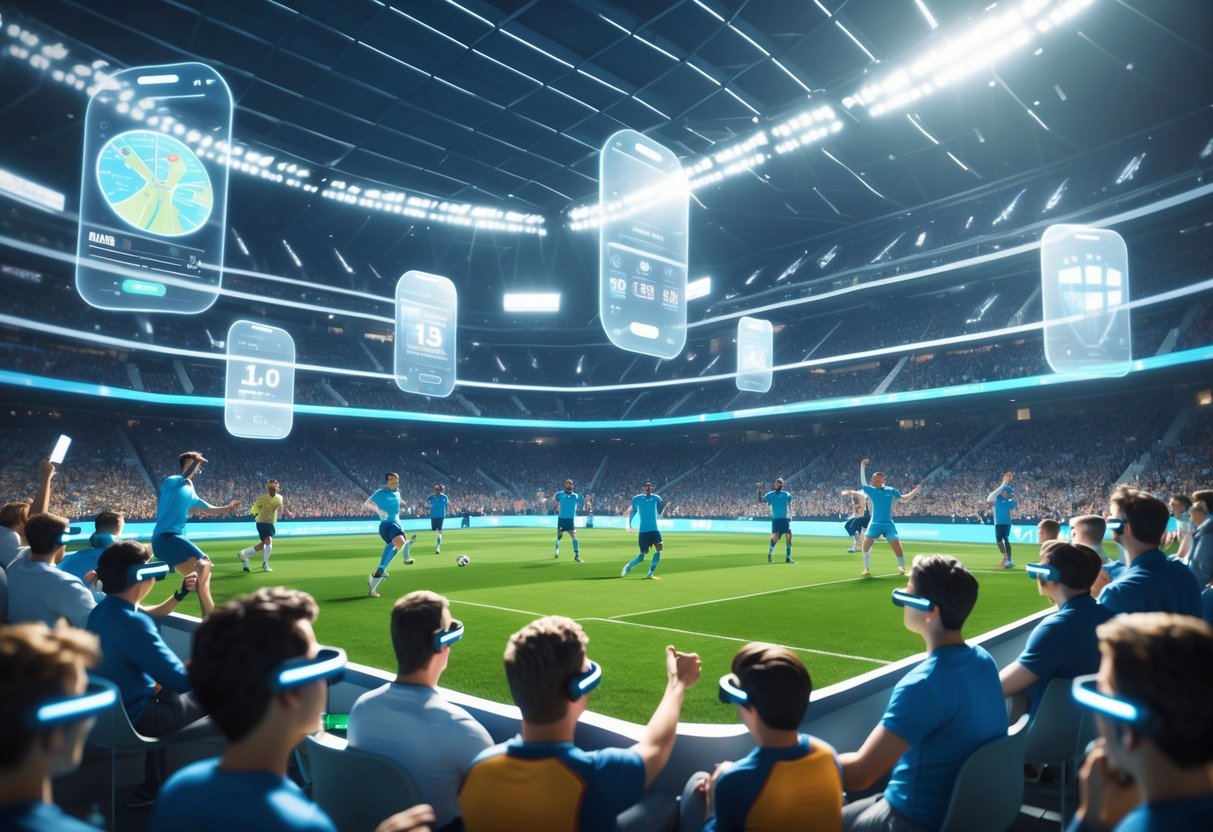
Real-world AR tech is already changing live sports viewing with digital overlays and immersive features. Two standout examples show how augmented reality is reaching fans.
HADO: The First AR Sport
HADO broke new ground as the world’s first AR sport made just for augmented reality viewing. Players wear AR headsets and dodge virtual energy balls, while spectators use their own AR devices or watch big screens with the action overlaid.
HADO’s spectator experience brings some unique challenges. To really get what’s happening, you need AR glasses or a smartphone. That’s a hurdle traditional sports just don’t have.
Key spectator features include:
- Real-time energy ball tracking for audiences
- Player health bars and scores floating in the viewing space
- Multiple camera angles showing both real movement and AR elements
Optimising HADO’s spectator experience takes some finesse. Viewers want to see virtual stuff clearly, but not lose sight of the real players.
The main issues are:
- Tech barriers: Not everyone owns AR devices
- Learning curve: New spectators often struggle to follow the action
- Venue limits: Lighting and space can mess with AR quality
Broadcasting and Digital Overlays in Sports
Traditional sports are using AR mainly through broadcasting and digital overlays, not by inventing whole new AR sports. Football matches now have virtual offside lines; tennis shows ball trajectories.
Common AR broadcasting features:
- Player stats floating above athletes during play
- Virtual markers for distances and measurements
- Real-time overlays for heart rates and performance data
Fans in the stadium can access these features with mobile apps. Just point your phone at the pitch to see player profiles, match stats, or interactive content during breaks.
The big advantage is accessibility. You only need a smartphone—no fancy headsets required. This method builds on existing sports instead of creating totally new ones.
Challenges here:
- Keeping data accurate during live play
- Battery drain on spectator phones
- Venue networks struggling with thousands of AR users
Broadcasting companies say fans engage more when AR features are optional, letting viewers pick how much digital content they want.
Challenges and Limitations of AR Spectator Features
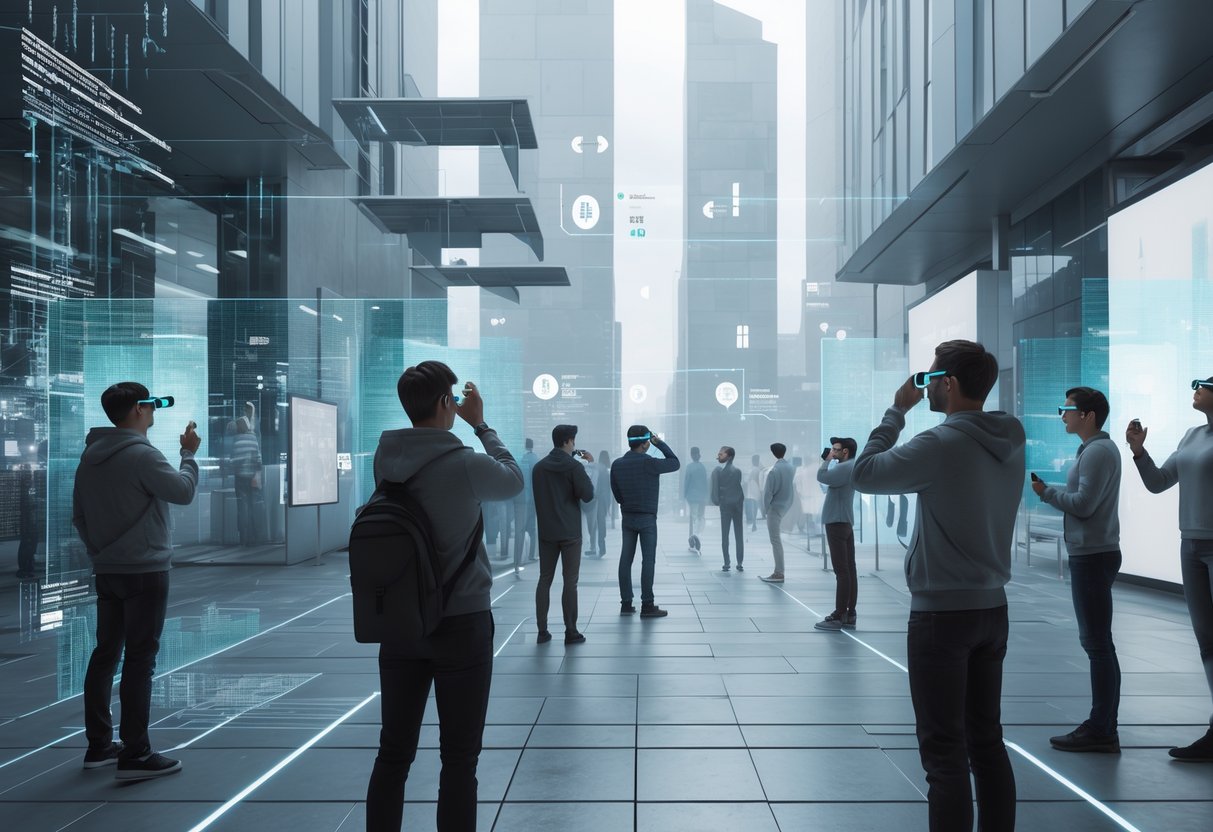
AR spectator tech still faces some big hurdles when it comes to delivering consistent experiences and reaching a bigger audience. Technical barriers and slow adoption are holding things back.
Technical Barriers and Platform Constraints
Hardware limitations make life tough for AR spectator apps. Most smartphones just can’t handle heavy AR processing and keep a steady frame rate.
Battery drain gets brutal during long events. A typical AR sports app can chew through 60–80% of your battery in a two-hour match.
Platform fragmentation leads to uneven experiences. AR Foundation helps bridge the gap between iOS and Android, but device performance varies wildly.
Network demands put real pressure on stadium infrastructure. AR apps need constant, fast data to keep graphics synced with live action. Stadium Wi-Fi often can’t keep up with thousands of AR users at once.
Processing delays cause sync issues. If AR overlays lag even two seconds behind real action, the experience falls apart.
Tracking accuracy also suffers in crowded places. AR systems have trouble keeping objects stable when thousands of people are moving around.
Accessibility and Adoption Rates
Cost barriers keep AR from reaching everyone. Most AR spectator features need newer smartphones, and those can set fans back £600 or more. That price tag puts them out of reach for a lot of budget-conscious people.
Learning curves scare off casual users. We’ve noticed spectators over 40 often give up on AR apps in just a few minutes because the interfaces feel confusing or awkward.
Physical comfort becomes an issue fast. People get arm fatigue after holding up their phones for AR viewing—usually within 15 or 20 minutes.
Data costs add another hurdle. AR spectator apps can burn through 2-4GB of data per hour, so anyone with a limited mobile plan faces a hefty bill.
Venue restrictions slow things down. Many stadiums ban AR devices or limit their use because of security worries about cameras and recording.
Demographic gaps still exist. Younger fans seem to love AR features, but older spectators usually stick with traditional viewing—no digital overlays for them.
Future Directions for AR Spectator Features
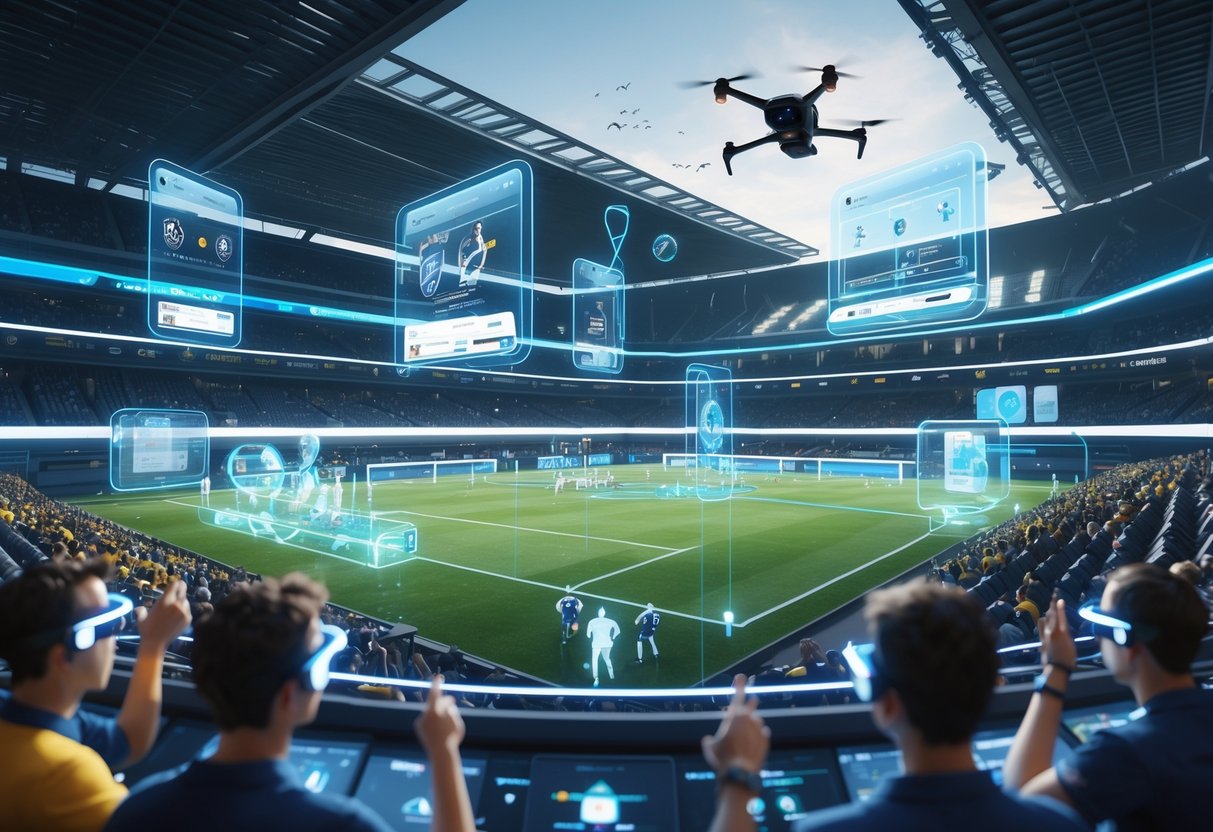
AR tech isn’t stopping at sports. We’ll probably see it show up at concerts and other entertainment events, blending with AI and VR. This mix will open up new ways for fans to connect with live events in all sorts of industries.
Advances in Immersive Technologies
AR will blend with VR and AI for richer, more realistic experiences. Imagine not just seeing player stats, but really feeling like you’re right there on the pitch next to your favourite players.
Right now, AR mostly shows us basics—scores and names. But future systems will use artificial intelligence to predict what each fan actually wants to see.
Smart AR systems will pick up on your habits. If you always check a player’s passing accuracy, the XR app will start showing that data automatically when that player gets the ball.
Fans will use voice commands to control their AR experience, ditching the need to tap on screens. Just say, “show me the goalkeeper’s save percentage,” and the info pops up.
5G networks will make everything faster and smoother. No more annoying delays between what’s happening on the field and what you see through your AR device.
Haptic feedback is coming, too. Imagine your phone buzzing when your team scores—a little jolt of excitement to go with the visuals.
Broader Applications Beyond Sports
Music festivals and concerts have started to borrow AR features from sports events. Fans can point their phones at the stage and see song lyrics, band bios, or even wild light shows.
Theatre and live performances will get a boost from AR translation. International audiences can see subtitles or cultural explanations on their devices, no need to disturb anyone else.
Museums and exhibitions already use AR for historical facts. We’re expecting this to grow into virtual guided tours and interactive displays that adjust to what visitors are curious about.
Gaming tournaments and esports events are jumping on AR features, too. Viewers can check out player strategies, in-game stats, or behind-the-scenes content right in the middle of matches.
Corporate events and conferences will use AR for networking. Just scan a name badge and see someone’s background or shared interests pop up in augmented reality.
Schools and universities will bring AR into lectures and presentations. Students can grab extra resources or join in interactive polls on their phones, all while keeping an eye on the speaker.
Frequently Asked Questions

Here are some common questions about how fans use AR during matches, which devices work best, and accessibility considerations that matter to spectators.
How can spectators interact with augmented reality during live events?
Spectators use AR-enabled apps on their phones or tablets to see real-time player statistics overlaid on the field. At some venues, you can point your device at different spots on the pitch and see heat maps showing where the action happened.
Interactive replays are catching on at big events. Fans can pick moments from the match and watch them from new angles using their device’s camera.
Some venues let people vote on AR features during breaks. You might choose which player stats to display or pick camera angles for instant replays.
What devices support the latest AR spectator technologies?
Most modern smartphones from the last three years can handle AR spectator apps. iPhones from the iPhone 8 and up work with ARKit apps, and Android devices running Android 7.0 or newer usually support ARCore.
Tablets work well because of their bigger screens. The iPad Pro and Samsung Galaxy Tab series give especially smooth AR experiences at live events.
A few venues are testing AR glasses and headsets, but usually, they provide those—fans don’t need to bring their own.
Are there any apps that enhance the viewing experience with augmented reality features?
Several sports leagues have official AR apps for their events. These apps offer player profiles, live stats, and interactive content when you point your device at the action.
Third-party apps like SportAR and MatchVision cover multiple sports and venues, though what they offer depends on the event.
Many venues add AR features to their own apps, alongside stuff like food ordering or seat finding. It’s worth checking your venue’s official app before you go.
What are some safety considerations when using AR as a spectator?
Keep an eye on your device in crowded venues. AR can be pretty immersive—you might forget to watch your stuff.
Try not to block other people’s views by holding up your phone or tablet for too long. It can get in the way, especially for folks behind you.
Watch your battery. AR features drain power fast, and you’ll want your phone working for the trip home.
How does augmented reality integration impact the accessibility of events for attendees?
AR can really help visually impaired spectators by using audio descriptions triggered when they point their devices at different areas. Some apps give detailed commentary about player positions and actions.
Hearing-impaired fans get visual overlays showing things like crowd noise, referee calls, and commentary in text. These appear on screen but don’t block the main action.
A lot of AR apps let you change text size or switch to high-contrast modes. That means spectators with all sorts of visual needs can get more out of the event.
Can you customise your augmented reality experience while attending a virtual event?
Most AR platforms for virtual events let you tweak your experience in the settings menu.
You can pick which stats you want to see. Adjusting overlay transparency is pretty easy, and you can even choose your favorite viewing angles.
If you want to focus on certain players or teams, content filtering comes in handy. This gets especially helpful during tournaments with several matches going on at once.
A lot of these platforms actually remember your preferences for next time. So, after you set up your AR just the way you like it, you won’t have to do it all over again for future events.

